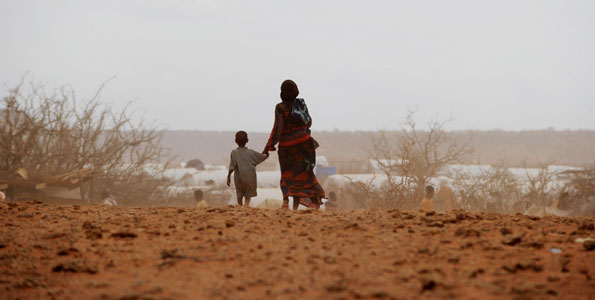Seydou Walaga, a grey-haired farmer in western Niger, lifts the hatch of his grain silo, a round hut made of sticks and straw, to reveal piles of sorghum and millet.
The crops were harvested nearly seven months ago, the longest a season’s yield has ever lasted him in the drought-prone region of West Africa’s Sahel, a semi-arid belt below the Sahara stretching from Senegal to Chad.
“My family is still eating the grain I harvested last year,” Walaga told the United States Agency for International Development (USAID), which has taught him and other farmers methods for increasing crop yields.
“In the years before, my crop only fed us for two months,” USAID quoted Walaga as saying in a case study.
The main difference, the farmer said, is a technique he started using called zai, pits dug in hardened farmland and filled with compost and manure. Seeds are planted inside at the start of the rainy season, and the pits boost crop productivity by concentrating scarce water and nutrients around the plants.
Zai is one of many techniques experts say have made communities across the Sahel better prepared to withstand drought since the last major dry spell in 2012 left 18 million people in need of assistance.
Following that emergency, many relief and development agencies in the region shifted their focus toward helping people prepare for and survive drought, rather than only providing aid after each recurring crisis.
Five years on, experts say the results are promising. Thousands of farmers have learned to use methods such as zai and stone bunds – low walls that slow run-off – to boost crop yields and restore large swathes of degraded land.
Scientists have also created new ways to collect and distribute climate data, setting up effective early warning systems for drought.
At the same time, the Global Alliance for Resilience (AGIR) – set up by the European Union and regional bodies – has pushed African governments to engage more in agricultural issues.
But the approach has been scattered and food insecurity remains high in the region. Many experts say the next step is to scale up successful programs to a national or regional level, requiring more long-term funding and government support.
AVERTING DISASTER
Scientists say programs that track weather patterns are critical for farmers in Africa where traditional methods of predicting the weather have become less reliable due to climate change – and are a top candidate for increased investment.
In Senegal, a project to provide detailed rainfall forecasts to farmers via radio programs made a significant difference during a 2014 drought, according to Robert Zougmore of the Climate Change, Agriculture and Food Security (CCAFS) program, which worked on the initiative with Senegal’s meteorological agency.
The service notified farmers before planting time that the season would be dry, and advised them to substitute their regular crops with varieties that required less water.
“It helped to avert a major disaster,” Zougmore, CCAFS’ West Africa program leader, told the Thomson Reuters Foundation.
The program has since expanded to reach up to 7 million rural people in Senegal, with similar projects underway in Burkina Faso, Mali and Niger.
While climate information services are crucial in the Sahel, the interventions that work best come from the communities themselves and are low-tech, Zougmore said.
Often the techniques have been around for decades but farmers need support to implement them or training to make them more effective and sustainable, experts say.
For example, in Chad and Niger, the World Food Programme (WFP) has paid villagers with cash or food to build dams and dykes, dig zai, and implement other projects that maximize water resources.
Nearly 1.5 million acres (607,028 hectares) of dry farmland have been restored in the past three years, much of it for use by the very poor, said WFP Niger country director Benoit Thiry.
In parts of Niger, WFP is even beginning to phase out food assistance because people have become self-sufficient, he said.
“We have been able to measure some improvement in the resilience of the population,” Thiry told the Thomson Reuters Foundation. “But there are lots of challenges.”
LONG-TERM COMMITMENT
Directors of international aid and development programs say they would like to work with communities over a longer period but struggle to obtain funding to match.
To create lasting change requires at least 15 to 20 years of support, said Sibiri Jean Zoundi, deputy director of an Organization for Economic Cooperation and Development (OECD) platform that oversees West African resilience network AGIR.
But five years is a more typical time-frame for programs such as USAID’s Resilience in the Sahel-Enhanced (RISE) project, launched after the region’s devastating drought in 2012.
Through RISE, USAID has spread conservation farming techniques and helped communities set up irrigation systems in especially exposed regions of Burkina Faso and Niger.
Some of the agencies with the longest history of working to combat drought in the Sahel are not international aid agencies but regional organizations such as the Permanent Interstate Committee for Drought Control in the Sahel (CILSS), founded in 1973.
CILSS scientist Seydou Traore said drought resilience has been gradually improving since before the 2012 crisis.
Nevertheless there has been greater national and international attention on resilience to drought since 2012, according to Zoundi of the AGIR network.
“It is too early to say whether most countries could overcome or prevent a drought, but they know what needs to be done,” Zoundi said.
“We have some very good practices in the region. We just need support to scale them up.”
Source: Reuters



